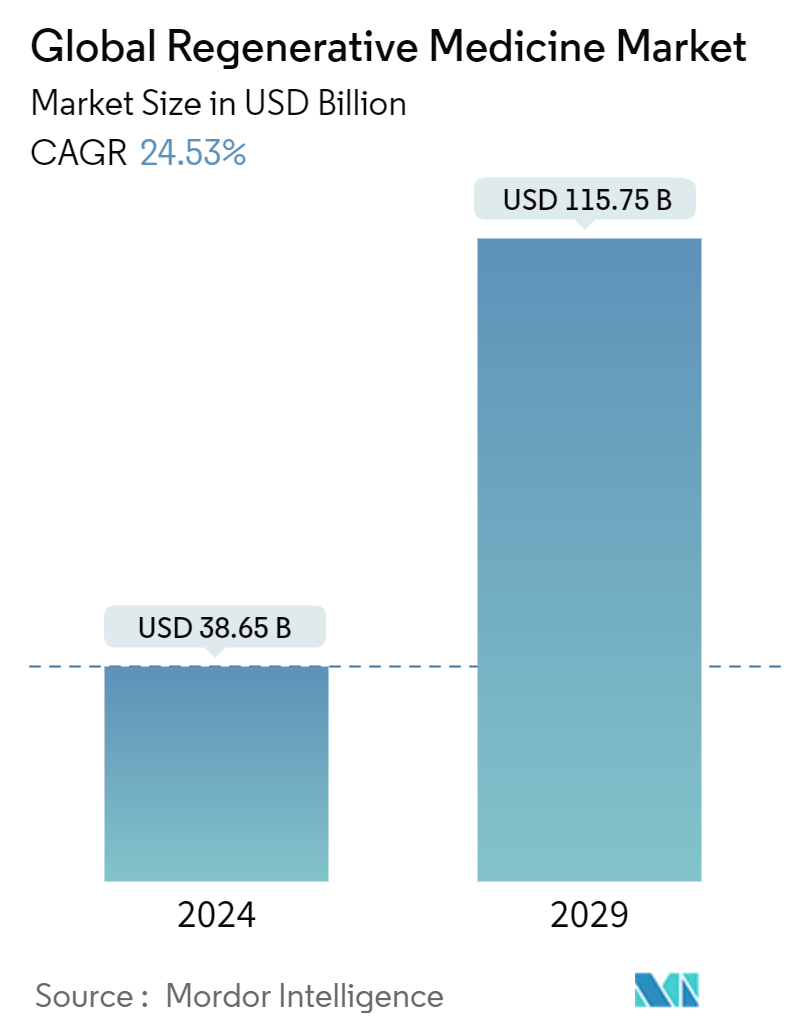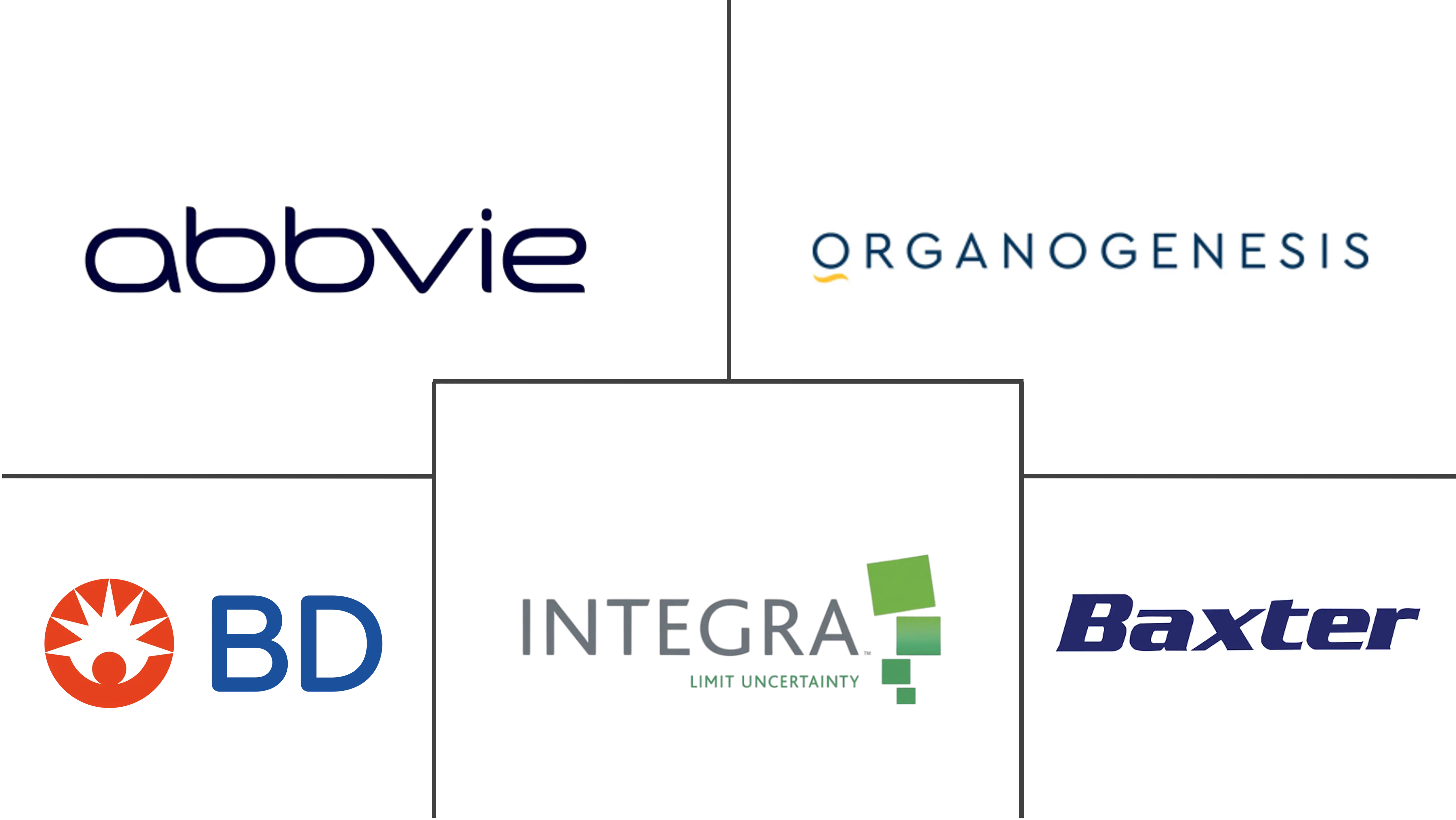Market Size of Global Regenerative Medicine Industry

| Study Period | 2019 - 2029 |
| Market Size (2024) | USD 38.65 Billion |
| Market Size (2029) | USD 115.75 Billion |
| CAGR (2024 - 2029) | 24.53 % |
| Fastest Growing Market | Asia Pacific |
| Largest Market | North America |
Major Players
*Disclaimer: Major Players sorted in no particular order |
Need a report that reflects how COVID-19 has impacted this market and its growth?
Regenerative Medicine Market Analysis
The Global Regenerative Medicine Market size is estimated at USD 38.65 billion in 2024, and is expected to reach USD 115.75 billion by 2029, at a CAGR of 24.53% during the forecast period (2024-2029).
Global Regenerative Medicine Market Industry Growth Drivers:
The Global Regenerative Medicine Market is experiencing robust growth, propelled by two primary factors: the rising adoption of stem cell technology and technological innovations in the field. With an aging global population and an increase in chronic diseases, regenerative medicine is seen as a breakthrough approach in addressing previously incurable conditions. This shift is expected to drive substantial growth and reshape treatment paradigms.
Increasing Adoption of Stem Cell Technology:
Stem cell technology is rapidly transforming the regenerative medicine landscape, marking a major shift in therapeutic approaches. Stem cells have a unique capacity to regenerate damaged tissues, positioning them as a cornerstone of modern medical innovation. Numerous research grants have been awarded to develop stem cell and gene therapy clinics, enhancing patient access and promoting global collaboration. Notably, new commercial ventures, such as off-the-shelf cell therapy products for knee osteoarthritis, exemplify the growing accessibility of stem cell therapies. These advancements bridge the gap between research and clinical application, expanding the reach of regenerative treatments.
Technological Advancements in Regenerative Medicine:
Technological innovation is playing a pivotal role in revolutionizing regenerative medicine. Emerging research in extracellular vesicles (EVs) shows potential to enhance tissue regeneration, with EVs positioned as an alternative to traditional stem cell therapies. Breakthroughs in nucleic acid-based nanomaterials and organoid technology are further driving progress in the sector. For example, tetrahedral framework nucleic acids (tFNAs) are gaining traction in targeted therapies for regenerating bone, skin, cartilage, and nerve tissues. These advancements not only improve therapeutic outcomes but also broaden the range of treatable conditions, from neurological disorders to musculoskeletal injuries.
The convergence of these drivers is creating a dynamic ecosystem for the Global Regenerative Medicine Market. The accelerated adoption of these technologies is poised to drive market growth, attract investment, and revolutionize healthcare delivery in the coming years.
Regenerative Medicine Industry Segmentation
As per the scope of the report, regenerative medicines are used to repair, replace, and regenerate the tissues and organs affected by injury, disease, or the natural aging process. These medicines restore the functionality of cells and tissues and are used in several degenerative disorders, such as dermatology, neurodegenerative diseases, cardiovascular, and orthopedics.
The regenerative medicine market is segmented by type of technology, application, and geography. By type of technology, the market is segmented into stem cell therapy, biomaterial, tissue engineering, and other types of technologies. By application, the market is segmented into bone graft substitutes, osteoarticular diseases, dermatology, cardiovascular, central nervous system and other applications. By geography, the market is segmented into North America, Europe, Asia-Pacific, Middle East and Africa, and South America. The market report also covers the estimated market sizes and trends for 17 different countries across major regions, globally. The report offers the value (in USD) for the above segments.
| By Type of Technology | |
| Stem Cell Therapy | |
| Biomaterial | |
| Tissue Engineering | |
| Other Types of Technologies |
| By Application | |
| Bone Graft Substitutes | |
| Osteoarticular Diseases | |
| Dermatology | |
| Cardiovascular | |
| Central Nervous System | |
| Other Applications |
| Geography | ||||||||
| ||||||||
| ||||||||
| ||||||||
| ||||||||
|
Global Regenerative Medicine Market Size Summary
The global regenerative medicine market is poised for significant expansion, driven by advancements in stem cell technologies, gene therapies, and tissue engineering. The market is experiencing a surge in interest due to the increasing adoption of these technologies and the supportive regulatory environment. Government initiatives and funding, particularly in countries like India, Australia, and the United States, are fostering research and development in this field. These efforts are complemented by numerous clinical trials and collaborations aimed at developing innovative therapies for various diseases, including cancer and diabetes. The COVID-19 pandemic has further accelerated interest in regenerative medicine, as stem cell therapies are being explored as potential treatments for the virus, thereby boosting market demand.
North America is expected to dominate the market, largely due to the presence of major industry players and substantial investments in research and development. The United States, in particular, is witnessing a growing prevalence of chronic diseases that can be addressed through regenerative medicine. The market is characterized by intense competition, with both large and small companies investing in novel technologies and strategic partnerships to enhance their market presence. Key players such as AbbVie Inc., Osiris Therapeutics, and Integra Lifesciences are leading the charge, while regulatory approvals and collaborations continue to pave the way for new therapies. As the field evolves, regenerative medicine is anticipated to revolutionize healthcare, offering promising solutions for previously incurable conditions.
Global Regenerative Medicine Market Size - Table of Contents
-
1. MARKET DYNAMICS
-
1.1 Market Overview
-
1.2 Market Drivers
-
1.2.1 Increasing Adoption of Stem Cell Technology
-
1.2.2 Technological Advancements in Regenerative Medicine
-
-
1.3 Market Restraints
-
1.3.1 Regulatory and Ethical Issues
-
1.3.2 High Cost of Treatments
-
-
1.4 Porter's Five Forces Analysis
-
1.4.1 Threat of New Entrants
-
1.4.2 Bargaining Power of Buyers/Consumers
-
1.4.3 Bargaining Power of Suppliers
-
1.4.4 Threat of Substitute Products
-
1.4.5 Intensity of Competitive Rivalry
-
-
-
2. MARKET SEGMENTATION (Market Size by Value – USD)
-
2.1 By Type of Technology
-
2.1.1 Stem Cell Therapy
-
2.1.2 Biomaterial
-
2.1.3 Tissue Engineering
-
2.1.4 Other Types of Technologies
-
-
2.2 By Application
-
2.2.1 Bone Graft Substitutes
-
2.2.2 Osteoarticular Diseases
-
2.2.3 Dermatology
-
2.2.4 Cardiovascular
-
2.2.5 Central Nervous System
-
2.2.6 Other Applications
-
-
2.3 Geography
-
2.3.1 North America
-
2.3.1.1 United States
-
2.3.1.2 Canada
-
2.3.1.3 Mexico
-
-
2.3.2 Europe
-
2.3.2.1 Germany
-
2.3.2.2 United Kingdom
-
2.3.2.3 France
-
2.3.2.4 Italy
-
2.3.2.5 Spain
-
2.3.2.6 Rest of Europe
-
-
2.3.3 Asia-Pacific
-
2.3.3.1 China
-
2.3.3.2 Japan
-
2.3.3.3 India
-
2.3.3.4 Australia
-
2.3.3.5 South Korea
-
2.3.3.6 Rest of Asia-Pacific
-
-
2.3.4 Middle East and Africa
-
2.3.4.1 GCC
-
2.3.4.2 South Africa
-
2.3.4.3 Rest of Middle East and Africa
-
-
2.3.5 South America
-
2.3.5.1 Brazil
-
2.3.5.2 Argentina
-
2.3.5.3 Rest of South America
-
-
-
Global Regenerative Medicine Market Size FAQs
How big is the Global Regenerative Medicine Market?
The Global Regenerative Medicine Market size is expected to reach USD 38.65 billion in 2024 and grow at a CAGR of 24.53% to reach USD 115.75 billion by 2029.
What is the current Global Regenerative Medicine Market size?
In 2024, the Global Regenerative Medicine Market size is expected to reach USD 38.65 billion.

